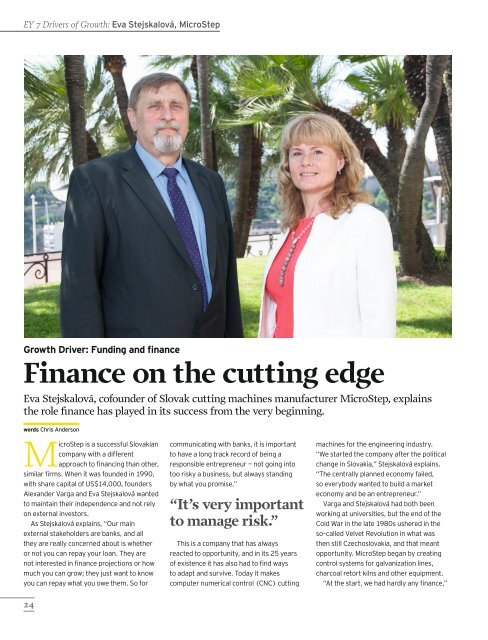Exceptional
ey-exceptional-2016-uki-book
ey-exceptional-2016-uki-book
You also want an ePaper? Increase the reach of your titles
YUMPU automatically turns print PDFs into web optimized ePapers that Google loves.
EY 7 Drivers of Growth: Eva Stejskalová, MicroStep<br />
Growth Driver: Funding and finance<br />
Finance on the cutting edge<br />
Eva Stejskalová, cofounder of Slovak cutting machines manufacturer MicroStep, explains<br />
the role finance has played in its success from the very beginning.<br />
words Chris Anderson<br />
MicroStep is a successful Slovakian<br />
company with a different<br />
approach to financing than other,<br />
similar firms. When it was founded in 1990,<br />
with share capital of US$14,000, founders<br />
Alexander Varga and Eva Stejskalová wanted<br />
to maintain their independence and not rely<br />
on external investors.<br />
As Stejskalová explains, “Our main<br />
external stakeholders are banks, and all<br />
they are really concerned about is whether<br />
or not you can repay your loan. They are<br />
not interested in finance projections or how<br />
much you can grow; they just want to know<br />
you can repay what you owe them. So for<br />
communicating with banks, it is important<br />
to have a long track record of being a<br />
responsible entrepreneur — not going into<br />
too risky a business, but always standing<br />
by what you promise.”<br />
“It’s very important<br />
to manage risk.”<br />
This is a company that has always<br />
reacted to opportunity, and in its 25 years<br />
of existence it has also had to find ways<br />
to adapt and survive. Today it makes<br />
computer numerical control (CNC) cutting<br />
machines for the engineering industry.<br />
“We started the company after the political<br />
change in Slovakia,” Stejskalová explains.<br />
“The centrally planned economy failed,<br />
so everybody wanted to build a market<br />
economy and be an entrepreneur.”<br />
Varga and Stejskalová had both been<br />
working at universities, but the end of the<br />
Cold War in the late 1980s ushered in the<br />
so–called Velvet Revolution in what was<br />
then still Czechoslovakia, and that meant<br />
opportunity. MicroStep began by creating<br />
control systems for galvanization lines,<br />
charcoal retort kilns and other equipment.<br />
“At the start, we had hardly any finance,”<br />
24


